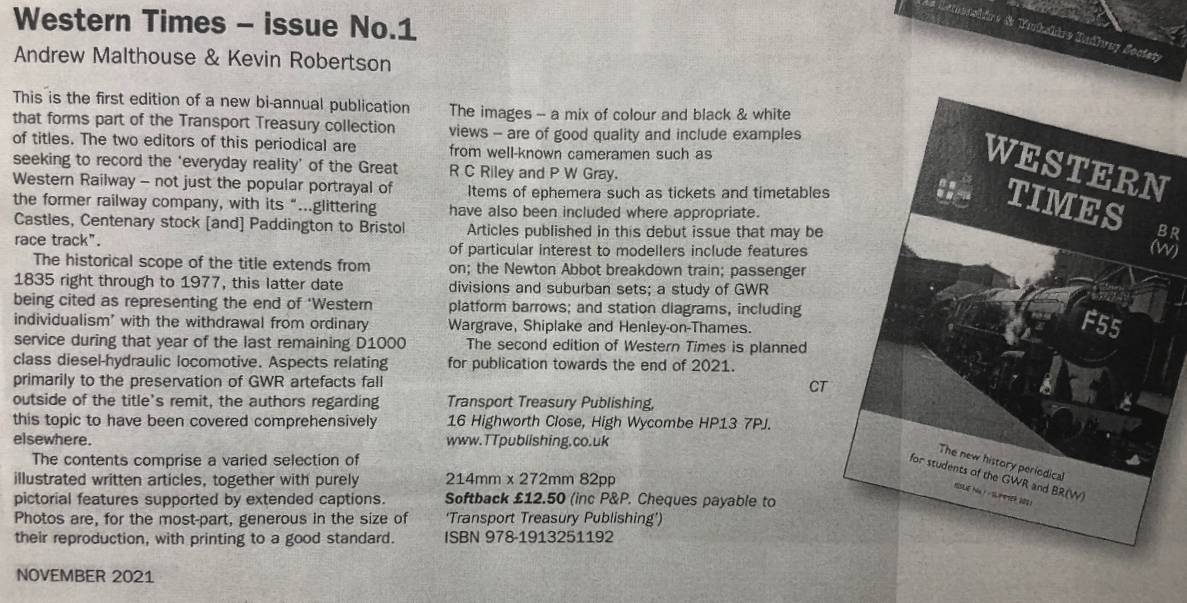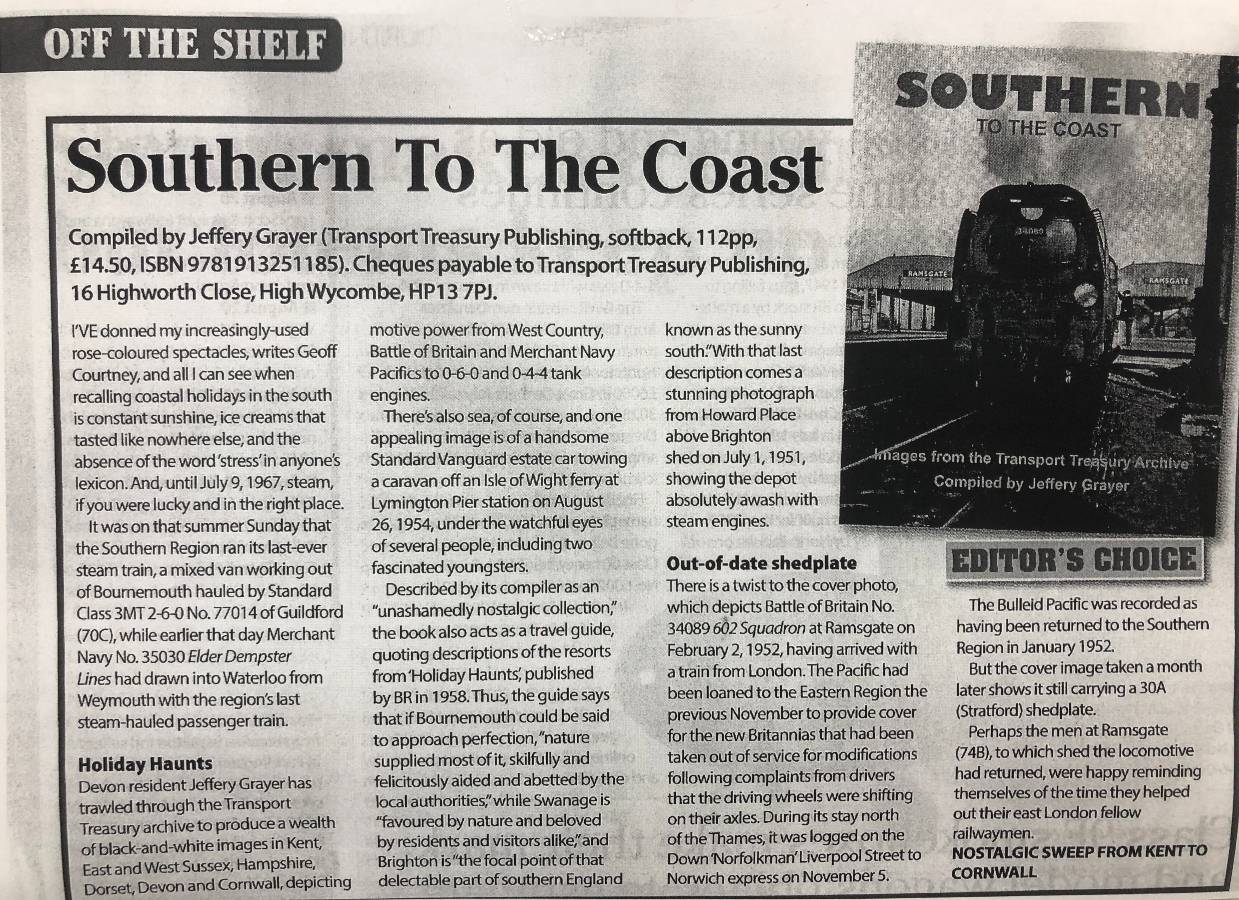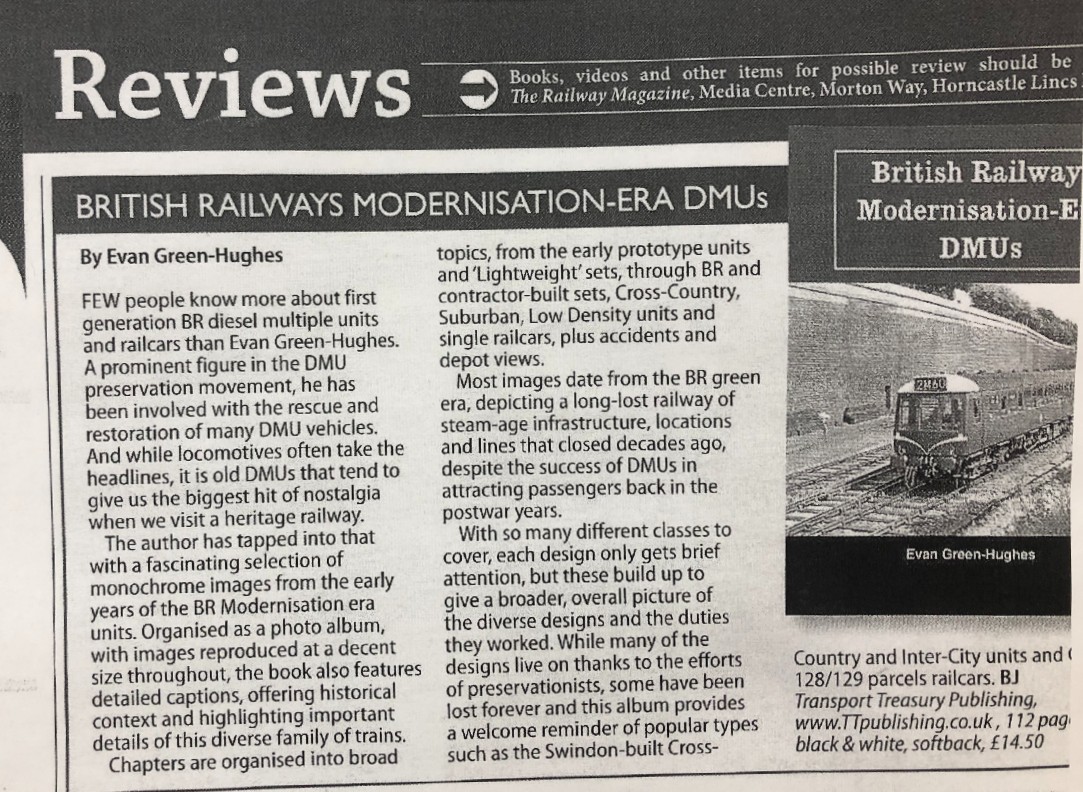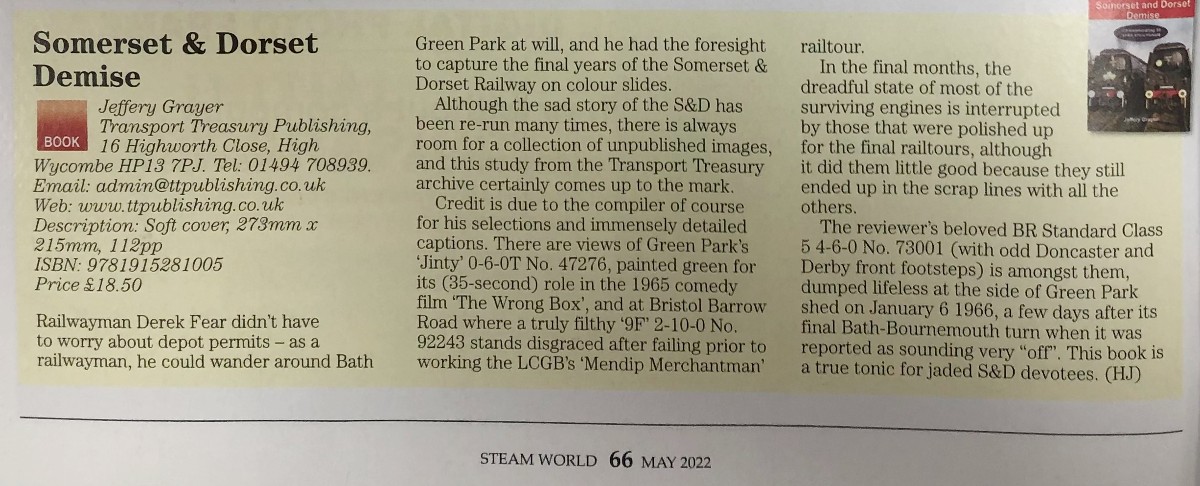Press Reviews
David Fleming2023-11-03T12:09:08+00:00Press Reviews
Transport Treasury Publishing
Press reviews of our books

The contents comprise a varied selection of illustrated written articles, together with purely pictorial features supported by extended captios. Photos are, for the most part, generous in the sizeof their reproduction, with printing to a good standard.
This is the first edition of a new bi-annual publication that forms part of the Transport Treasury collection of titles. The two editors of this periodical are seeking to record the ‘everyday reality of the Great Western Railway – not just the popular portrayal of the former railway company, with its “…glittering Castles, Centenary stock [and] Paddington to Bristol race track”.
The historical scope of the title extends from 1835 right through to 1977, this latter date being cited as representing the end of ‘Western individualism’ with the withdrawal from ordinary service during that year of the last remaining D1000 class diesel-hydraulic locomotive. Aspects relating primarily to the preservation of GWR artefacts fall outside of the title’s remit, the authors regarding this topic to have been covered comprehensively elsewhere.
The contents comprise a varied selection of illustrated written articles, together with purely pictorial features supported by extended captions. Photos are, for the most part, generous in the size of their reproduction, with printing to a good standard. The images – a mix of colour and black & white views – are of good quality and include examples from well-known cameramen such as RC Riley and P W Gray.
Items of ephemera such as tickets and timetables have also been included where appropriate. Articles published in this debut issue that may be of particular interest to modellers include features on; the Newton Abbot breakdown train; passenger divisions and suburban sets; a study of GWR platform barrows; and station diagrams, including Wargrave, Shiplake and Henley-on-Thames. The second edition of Western Times is planned for publication towards the end of 2021.

Devon resident Jeffery Grayer has trawled through the Transport Treasury archive to produce a wealth of black-and-white images in Kent, East and West Sussex, Hampshire, Dorset, Devon and Cornwall, depicting motive power from West Country, Battle of Britain and Merchant Navy Pacifics to 0-6-0 and 0-4-4 tank engines.
I’ve donned my increasingly-used rose-coloured spectacles, writes Geoff Courtney, and all I can see when recalling coastal holidays in the south is constant sunshine, ice creams that tasted like nowhere else, and the absence of the word ‘stress’ in anyone’s lexicon. And, until July 9, 1967, steam, if you were lucky and in the right place.
It was on that summer Sunday that the Southern Region ran its last-ever steam train, a mixed van working out of Bournemouth hauled by Standard Class 3MT 2-6-0 No. 77014 of Guildford (70C), while earlier that day Merchant Navy No.35030 Elder Dempster Lines had drawn into Waterloo from Weymouth with the region’s last steam-hauled passenger train.
Devon resident Jeffery Grayer has trawled through the Transport Treasury archive to produce a wealth of black-and-white images in Kent, East and West Sussex, Hampshire, Dorset, Devon and Cornwall, depicting motive power from West Country, Battle of Britain and Merchant Navy Pacifics to 0-6-0 and 0-4-4 tank engines. There’s also sea, of course, and one appealing image is of a handsome Standard Vanguard estate car towing a caravan off an Isle of Wight ferry at Lymington Pier station on August 26, 1954, under the watchful eyes of several people, including two fascinated youngsters.
Described by its compiler as an “unashamedly nostalgic collection.” the book also acts as a travel guide, quoting descriptions of the resorts from Holiday Haunts, published by BR in 1958. Thus, the guide says that if Bournemouth could be said to approach perfection, “nature supplied most of it, skilfully and felicitously aided and abetted by the local authorities’ while Swanage is “favoured by nature and beloved by residents and visitors alike” and Brighton is “the focal point of that delectable part of southern England known as the sunny south.” With that last description come stunning photograph from Howard Place above Brighton shed on July 1, 1951, showing the depot absolutely awash with steam engines.
There is a twist to the cover photo, which depicts Battle of Britain No. 34089 602 Squadron at Ramsgate on February 2, 1952, having arrived with a train from London. The Pacific had been loaned to the Eastern Region the previous November to provide cover for the new Britannias that had been taken out of service for modifications following complaints from drivers that the driving wheels were shifting on their axles. During its stay north of the Thames, it was logged on the Down ‘Norfolkman’ Liverpool Street to Norwich express on November 5.
The Bulleid Pacific was recorded as having been returned to the Southern Region in January 1952. But the cover image taken a month later shows it still carrying a 30A (Stratford) shedplate. Perhaps the men at Ramsgate (74B), to which shed the locomotive had returned, were happy reminding themselves of the time they helped out their east London fellow railwaymen.

Few people know more about first generation BR diesel multiple units and railcars than Evan Green-Hughes.
Few people know more about first generation BR diesel multiple units and railcars than Evan Green-Hughes. A prominent figure in the DMU preservation movement, he has been involved with the rescue and restoration of many DMU vehicles. And while locomotives often take the headlines, it is old DMUS that tend to give us the biggest hit of nostalgia when we visit a heritage railway.
The author has tapped into that with a fascinating selection of monochrome images from the early years of the BR Modernisation era units. Organised as a photo album, with images reproduced at a decent size throughout, the book also features detailed captions, offering historical context and highlighting important details of this diverse family of trains. Chapters are organised into broad topics, from the early prototype units and ‘Lightweight’ sets, through BR and contractor-built sets, Cross-Country, Suburban, Low Density units and single railcars, plus accidents and depot views.
Most images date from the BR green era, depicting a long-lost railway of steam-age infrastructure, locations and lines that closed decades ago, despite the success of DMUs in attracting passengers back in the postwar years.
With so many different classes to cover, each design only gets brief attention, but these build up to give a broader, overall picture of the diverse designs and the duties they worked. While many of the designs live on thanks to the efforts of preservationists, some have been lost forever and this album provides a welcome reminder of popular types such as the Swindon-built Cross-Country and Inter-City units.

Credit is due to the compiler of course for his selections andimmensely detailed captions.
ailwayman Derek Fear didn’t have to worry about depot permits – as a railwayman, he could wander around Bath Green Park at will, and he had the foresight to capture the final years of the Somerset & Dorset Railway on colour slides.
Although the sad story of the S&D has been re-run many times, there is always room for a collection of unpublished images, and this study from the Transport Treasury archive certainly comes up to the mark.
Credit is due to the compiler of course for his selections and immensely detailed captions. There are views of Green Park’s ‘Jinty’ 0-6-0T No. 47276, painted green for its (35-second) role in the 1965 comedy film ‘The Wrong Box’, and at Bristol Barrow Road where a truly filthy ‘9F”‘ 2-10-0 No. 92243 stands disgraced after failing prior to working the LCGB’s ‘Mendip Merchantman’ railtour.
In the final months, the dreadful state of most of the surviving engines is interrupted by those that were polished up for the final railtours, although it did them little good because they still ended up in the scrap lines with all the others.
The reviewer’s beloved BR Standard Class 5 4-6-0 No. 73001 (with odd Doncaster and Derby front footsteps) is amongst them, dumped lifeless at the side of Green Park shed on January 6 1966, a few days after its final Bath-Bournemouth turn when it was reported as sounding very “off”. This book is a true tonic for jaded S&D devotees.
The legacy of renowned photographers on your doorstep
- Shipped in 24 Hours
- No Quibble Returns
"Saving the nation's pictorial heritage"
Subscribe to Our Newsletter
Get all the latest information on Events, Sales and Offers.

